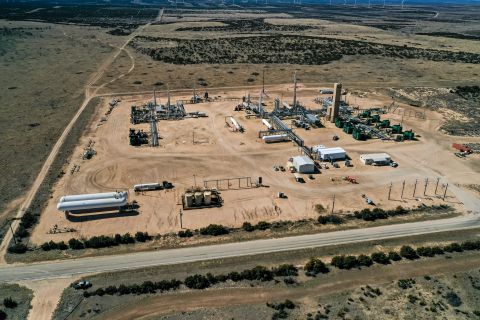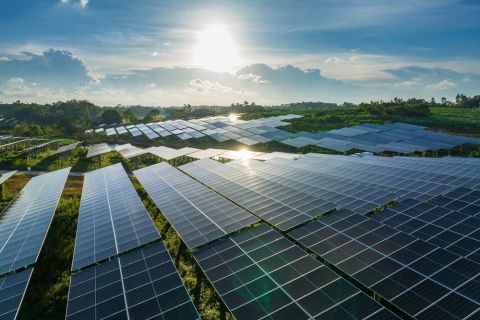
Trent Bridges brings years of oil and gas law experience to his new role as partner with Sidley Austin. (Source: Hart Energy; Sidley Austin; LuckyStep, Alhovik/Shutterstock.com)
Trent Bridges returned to the realm of law firms in September when he joined Sidley Austin’s energy and infrastructure practice as a partner in the Houston office. Bridges had spent the previous nine years in various legal roles for Magellan Midstream Partners LP, most recently as vice president and assistant general counsel.
One month into his new role, Bridges shared his thoughts on the midstream sector.
What convinced you to return to practicing at a law firm after almost nine years at Magellan Midstream Partners?
The last nine years at Magellan were great from a career development standpoint. I was fortunate from a timing perspective to have been very involved in the midstream industry’s response to the shale revolution, which included Magellan and its peers constructing significant new crude oil pipeline and terminal infrastructure. It enabled me to work on projects and develop relationships with a very deep list of contacts from companies across the energy value chain.
There’s an entrepreneurial aspect of private practice that’s very appealing to me, and I thought the timing to return to private practice and leverage that experience and those contacts couldn’t be better. And as a very active and hands-on M&A and project development practitioner during my Magellan tenure, the shift to private practice and the role I play for clients really isn’t that different from a day-to-day standpoint.
The oil and gas industry is facing a future in which fossil fuels seem destined to occupy a smaller share of the energy mix, but will still play a critical role. What should companies consider as they develop their medium- and long-term strategies?
While the oil and gas industry is certainly facing challenging regulatory and alternative energy headwinds, demand for the industry’s products isn’t going away any time soon and such products will continue to be the most fundamental and reliable energy sources for the time being.
That said, the headwinds the industry faces aren’t going to subside either, and it’ll be key for oil and gas companies to include to some extent in their strategic outlook how to best address and balance their legacy oil and gas business with investments in alternative energy and carbon reduction projects.
For the midstream business in particular, there isn’t a uniform strategic approach. For example, a public midstream company’s investors may expect more traditional returns on the deployment of capital in speculative alternative energy projects than a privately backed midstream company. And a midstream company with only liquids infrastructure might not find as many flexible opportunities for repurposing assets as a company that also has an existing gas footprint.
Finding the right strategic “mix” between legacy and new businesses will be a very complex legal and business undertaking for boards and management teams of oil and gas companies for the foreseeable future.
Has the approach to negotiating contracts between shippers and pipeline companies changed over the years? What is the status and outlook for negotiating and renegotiating shipper contracts?
Yes, negotiating shipper contracts has changed significantly over the years. It’s become much more competitive and difficult for oil pipeline companies in particular as a result of the midstream industry’s own creation of an overbuilt market.
Especially in today’s reduced oil production environment, there’s much more pipeline capacity than there are available barrels to ship. So, shippers are able to extract very favorable terms from midstream companies.
Pipeline operators and their legal and business teams have to find creative, yet regulatorily compliant, contracting and tariff design solutions to try to keep systems contracted at profitable rates. The timing is difficult, too, as many anchor shipper contracts on systems built in the last five to 10 years are expiring and operators are having to re-contract in such an economically challenging environment.
There has been some consolidation in the midstream space since the onset of the COVID-19 pandemic. What is your outlook for consolidation over the next six months and over the next few years?
Given the overbuilt nature of certain midstream sectors and a multitude of regulatory and alternative energy pressures, I think we’re going to see significant consolidation among midstream companies now and in the coming years.
It’s going to become very difficult for the less disciplined, financially weaker companies with fewer strategic resources and scope to effectively compete. Consolidation could be both at the asset level among operators combining assets in new joint ventures and creative commercial contracting structures, and in the M&A arena with entity-level combinations.
To effect certain of these combinations, though, the industry will also face much greater antitrust scrutiny from the FTC and DOJ—so really no layups on any front for the midstream space.
The vast U.S. gas pipeline network has been mentioned as a natural complement to the transport of hydrogen. Can you describe the challenges facing companies that are contemplating a move in that direction?
In addition to the balancing of legacy and alternative energy business models, my understanding is there are a number of technical obstacles and operational limitations on converting existing gas pipeline networks to pure or partial hydrogen transportation. Additionally, the federal regulatory framework for common carrier hydrogen pipeline transportation rates and terms of service may not be fully formed and could entail the issuance of more specific regulations or guidelines, which until known could add regulatory uncertainty to projects that already face operational and economic challenges.
How should an oil and gas company move most effectively toward incorporating renewable fuels into its product offerings?
Again, I think that strategy depends on the identity of each company and its unique industry position, economic pressures and existing asset base, but should involve actively analyzing how renewable fuels projects may best fit within its particular situation, identifying short- and long-term potentially viable projects, and seeking a clear understanding of any regulatory, contractual and economic issues in executing on such projects.
How are capital markets treating midstream companies at the moment?
Investors are expecting midstream companies to exert significant discipline on material business matters such as: carefully vetting capital expenditure programs; funding projects from cash flow; improving leverage metrics and distribution coverage; ensuring entity and tax structures are extracting the most intrinsic value; finding the best ways to return capital to equity holders; and thoughtfully and meaningfully implementing ESG programs.
In today’s environment, such discipline is really the ante for midstream companies to access the capital markets on favorable terms. Gone are investors’ appetites for providing cheap capital to midstream operators pursuing speculative growth projects and that have riskier financial profiles. And this capital markets pressure will make it even more difficult for certain midstream companies to take on risks and execute alternative energy and carbon reduction projects that aren’t natural complements to their legacy business models.
What kind of impact can we expect, near- and long-term, from energy policies, both at the federal and state government levels?
I don’t think there’s any question that the new federal administration’s policy changes have already had an immediate impact on the oil and gas industry on everything from, for example, enhanced securities filing disclosures on ESG matters, increased antitrust review and scrutiny of mergers and acquisitions, and heightened environmental analysis and approval conditions for new projects.
But regardless of which party is in office, and whether at the federal or state level, there’s definitely enough momentum behind climate change and alternative energy initiatives, and the government’s role in regulating these areas, that energy policies are going to play an even more key role to oil and gas industry participants moving forward.
Recommended Reading
Midstream M&A Adjusts After E&Ps’ Rampant Permian Consolidation
2024-10-18 - Scott Brown, CEO of the Midland Basin’s Canes Midstream, said he believes the Permian Basin still has plenty of runway for growth and development.
SM Energy Adds Petroleum Engineer Ashwin Venkatraman to Board
2024-12-04 - SM Energy Co. has appointed Ashwin Venkatraman to its board of directors as an independent director and member of the audit committee.
Baker Hughes Wins Contracts for Woodside’s Louisiana LNG Project
2024-12-30 - Bechtel has ordered gas technology equipment from Baker Hughes for the first phase of Woodside Energy Group’s Louisiana LNG development.
BP Profit Falls On Weak Oil Prices, May Slow Share Buybacks
2024-10-30 - Despite a drop in profit due to weak oil prices, BP reported strong results from its U.S. shale segment and new momentum in the Gulf of Mexico.
J.P. Morgan, Capital One Commit $260MM to Arizona Solar Project
2024-10-15 - Arizona’s Box Canyon solar project secured a $260 million tax-equity financing commitment from Capital One and an affiliate of J.P. Morgan.
Comments
Add new comment
This conversation is moderated according to Hart Energy community rules. Please read the rules before joining the discussion. If you’re experiencing any technical problems, please contact our customer care team.






